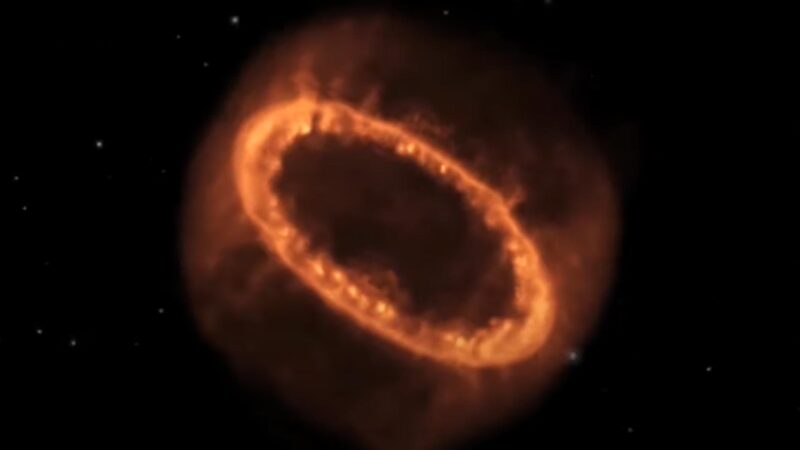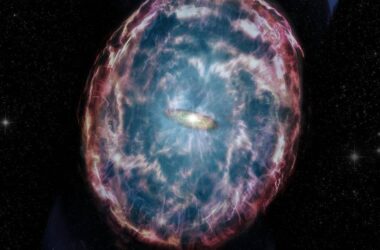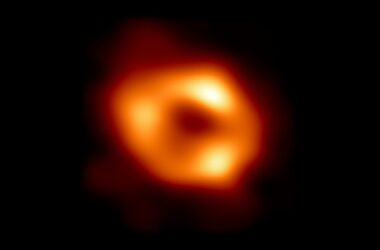
Lorsqu’une étoile explose en supernova, elle laisse parfois un vestige en forme d’anneau, comme on le voit ici dans cette illustration de SN 1987A. Crédit : NASA/CXC/A. Hobart
Des chercheurs de l’Université de Western Sydney, en collaboration avec une équipe internationale d’experts, ont découvert un mystérieux anneau circulaire près de notre galaxie voisine qui pourrait être le premier cas connu d’un reste de supernova intergalactique – des restes d’une étoile explosée qui pourraient avoir jusqu’à 7000 ans.
Baptisé J0624-6948, ce vestige de supernova ” dévoyé ” par les scientifiques se trouve très probablement dans le Grand Nuage de Magellan (LMC), une galaxie satellite du Milky Way – and its position suggests a previously unobserved origin.
Published in the prestigious journal Monthly Notices of the Royal Astronomical Society, lead author Professor Miroslav Filipovic from the University’s School of Science said the discovery was exciting and raised many unanswered questions.
“When we originally discovered this almost perfectly circular radio object we thought it was yet another ORC (Odd Radio Circle) but after our additional observations, it became clear that this object is much more likely to be something else,” said Professor Filipovic.
The ring that was discovered has significant differences to the five other known ORCs — a flatter radio spectral index, lack of a prominent central galaxy as a possible host, and larger apparent size — that all suggest it may be a different type of object.
“The most plausible explanation is that the object is an intergalactic Supernova Remnant due to an exploded star that resided in the Large Magellanic Cloud outskirts that had undergone a single-degenerate type Ia supernova which involves the explosion of two stars orbiting each other,” said Professor Filipovic.
“However, we considered other scenarios such as that this object might represent a remnant of the super-flare activity from a nearby Milky Way star (at only 190 light years away from Sun) that happened only a few centuries ago, or the premise that it may in fact be a much larger ORC.
“What we’ve potentially then discovered is a unique remnant of supernova that has expanded into a rarefied, intergalactic environment — an environment that we didn’t expect to find in such an object. Our estimates point to the age of about 2200 to 7100 years old.”
J0624–6948 was first detected with the Australian Square Kilometre Array Pathfinder (ASKAP) managed by CSIRO – one of several new generation radio telescopes that are revealing new features of the Universe.
“These new radio telescopes can pick up a range of spherical objects, and due to the combined effects of high-sensitivity, good spatial sampling, and wide area coverage, they are enriching our understanding of the Universe.”
Reference: “Mysterious odd radio circle near the large magellanic cloud – an intergalactic supernova remnant?” Miroslav D Filipović, J L Payne, R Z E Alsaberi, R P Norris, P J Macgregor, L Rudnick, B S Koribalski, D Leahy, L Ducci, R Kothes, H Andernach, L Barnes, I S Bojičić, L M Bozzetto, R Brose, J D Collier, E J Crawford, R M Crocker, S Dai, T J Galvin, F Haberl, U Heber, T Hill, A M Hopkins, N Hurley-Walker, A Ingallinera, T Jarrett, P J Kavanagh, E Lenc, K J Luken, D Mackey, P Manojlović, P Maggi, C Maitra, C M Pennock, S Points, S Riggi, G Rowell, S Safi-Harb, H Sano, M Sasaki, S Shabala, J Stevens, J Th van Loon, N F H Tothill, G Umana, D Urošević, V Velović, T Vernstrom, J L West, Z Wan, 4 February 2022, Monthly Notices of the Royal Astronomical Society.
DOI: 10.1093/mnras/stac210




